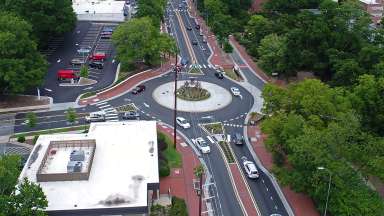Jump To:
Features of the Modern Roundabout
Raised Central Island: the main physical feature of a roundabout.
Designed to control the direction of traffic and reduce the speed of traffic to 20 miles per hour or less.
Truck Apron: the raised section of concrete around the center island.
The truck apron acts as an extra lane for large vehicles. The back wheels of large vehicles can ride up on the apron, so it can easily complete the turn, while the raised portion discourages use by smaller vehicles.
Splitter Islands: the triangular islands found when approaching a roundabout.
They are designed to slow and guide traffic. The islands also direct traffic to the right providing a soft righthand entrance to the roundabout. This action reduces the amount of T-bone or head-on collisions typically found at traditional intersections. The islands also provide refuge for pedestrians, giving them a safe place to wait while they cross one direction of traffic at a time. It is important to note that pedestrians have the right of way at these crosswalks.
Safety
Roundabouts are designed to make intersections more efficient and safer for drivers, pedestrians and bicyclist.
They reduce vehicle speed using geometry rather than traffic signals, causing the traffic to flow at a slow but steady pace. Roundabouts are designed for slow operating speeds between 15 and 25 mph.
Did you know? Low-speeds created by roundabouts reduces crash severity for motor vehicles, pedestrians, and bicyclists (pedestrians are three times more likely to die when struck at 30 mph than 20 mph)
Roundabouts reduce the amount of conflict points compared to the that of a typical intersection.
A typical 4 way stop intersection has 32 possible vehicle conflict points and 24 pedestrian conflict points, while a roundabout has 8 vehicular conflict points and 8 pedestrian conflict points.
A Roundabout is not a Traffic Circle
Traffic circles (also called rotaries) are found on the east coast and in Europe. The traffic circle is larger than the roundabout and normally includes stop signs or traffic signals that will stop traffic inside the circle. Dupont Circle in Washington, DC, is an excellent example of a traffic circle. Drivers enter a traffic circle straight on with a stop sign or traffic signal. Traffic circles can become congested if traffic signals allow too many vehicles to enter at the same time.
The roundabout enables vehicles to enter at a soft right turn, yielding to traffic already in the roundabout. This action allows for a smooth transition making it rare for a roundabout to get congested.

